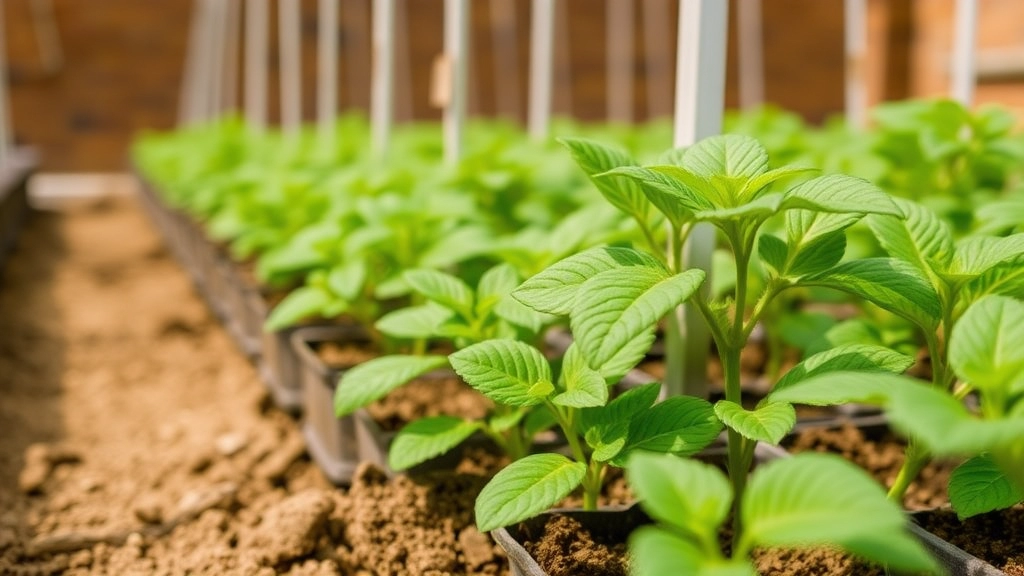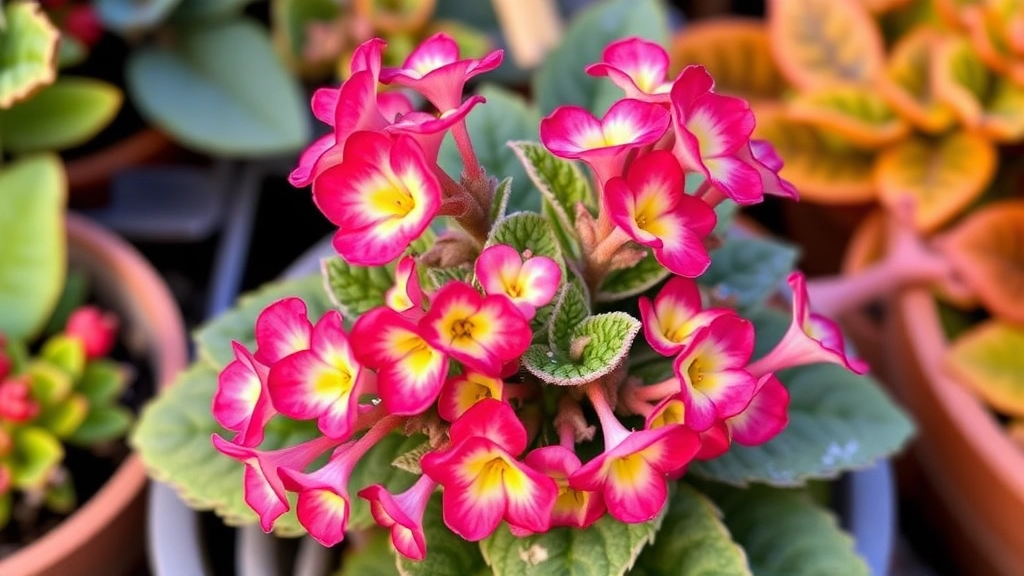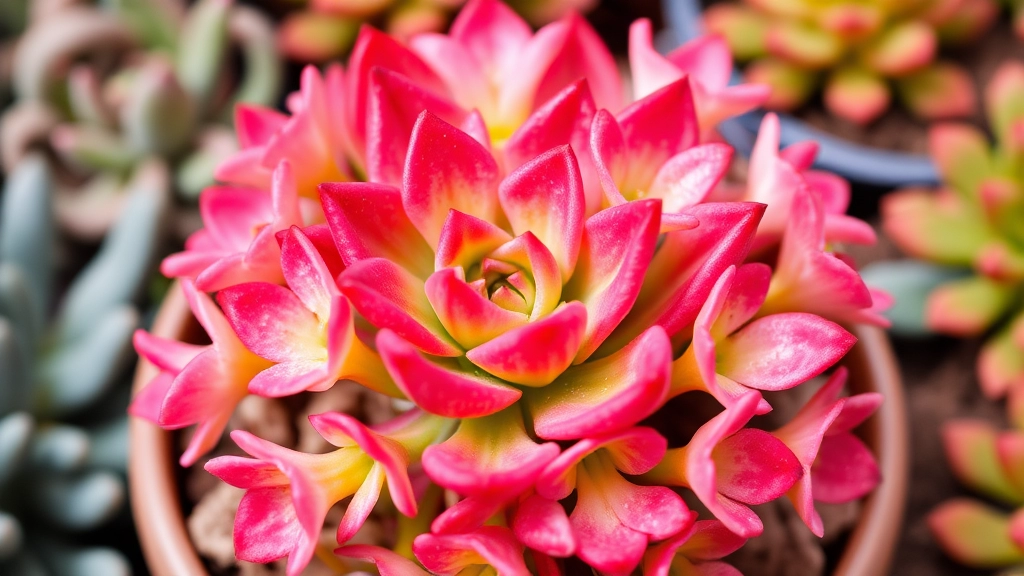Succulent Kalanchoe Tomentosa
Overview
Kalanchoe Tomentosa, also known as the Panda Plant, is a unique and eye-catching addition to any succulent collection. Recognisable by its velvety leaves adorned with brown spots, this plant brings a touch of whimsy and texture to your indoor garden. Whether you’re a seasoned succulent enthusiast or a beginner, understanding the characteristics and care requirements of Kalanchoe Tomentosa is essential for keeping it healthy and thriving.
Care Requirements
To ensure your Kalanchoe Tomentosa flourishes, it’s important to provide the right growing conditions. This succulent prefers bright, indirect light and thrives in well-draining soil, such as a mix of loam and sand. Watering should follow the “soak and dry” method to prevent overwatering, which can lead to root rot. With proper care, your Panda Plant will not only survive but also become a standout feature in your plant collection.
Are you curious about Kalanchoe Tomentosa and what makes it a standout choice for succulent enthusiasts?
Kalanchoe Tomentosa, commonly known as the “Panda Plant,” is a delightful succulent that captivates with its unique features.
– **Fuzzy Leaves**: The leaves are thick, oval-shaped, and covered in fine hairs, giving them a soft, velvety texture.
– **Distinctive Colouration**: The leaves typically exhibit a green hue with striking reddish-brown edges, adding a pop of colour to any collection.
– **Compact Growth**: This plant tends to grow in a compact manner, making it ideal for small spaces or as a tabletop feature.
– **Height and Spread**: It usually reaches about 30-45 cm (12-18 inches) in height, with a similar spread, making it manageable for indoor gardening.
– **Flowering**: While not its primary appeal, Kalanchoe Tomentosa can produce small, tubular flowers that bloom in clusters, typically in the spring.
These characteristics make Kalanchoe Tomentosa not only visually appealing but also a resilient addition to your plant collection. For more tips on how to care for flowering Kalanchoe, check out our [care guide for flowering Kalanchoe](https://planthq.org/care-guide-for-flowering-kalanchoe-2030cm-tall-blossfeldiana/). Additionally, if you’re interested in the best soil for your Kalanchoe, our [best soil for Kalanchoe Blossfeldiana care tips](https://planthq.org/best-soil-for-kalanchoe-blossfeldiana-care-tips/) might be helpful.
Ideal Growing Conditions

So, you’ve got your Kalanchoe Tomentosa and you’re wondering where to put it, right?
Finding the perfect spot for this charming succulent can make all the difference in its growth and overall health.
Light Requirements
- Bright, Indirect Light: Kalanchoe Tomentosa thrives in bright, indirect sunlight.
- Avoid Direct Sun: Too much direct sun can scorch those lovely leaves.
Temperature Preferences
- Warm Temperatures: Ideally, keep it in a range of 20°C to 25°C during the day.
- Cool Nights: It can tolerate cooler nights, but try not to drop below 10°C.
Humidity Levels
- Low Humidity: This plant prefers drier air, so if you live in a humid area, make sure it has good airflow.
- Avoid Misting: Unlike some houseplants, Kalanchoe doesn’t need misting.
Location Tips
- Indoor vs. Outdoor: If you’re indoors, a south or west-facing window is perfect.
- Outdoor Placement: If you’re putting it outside, find a sheltered spot that gets plenty of light but is protected from harsh afternoon sun.
When it comes to caring for Kalanchoe Tomentosa, understanding the right watering techniques is crucial for its health and growth.
One of the most common concerns for plant owners is overwatering.
– **Frequency:** Water your Kalanchoe Tomentosa every 2-3 weeks. Adjust this based on the season; they require less water in winter.
– **Soil Check:** Always check the top inch of the soil. If it feels dry, it’s time to water. If it’s still moist, wait a few more days.
– **Watering Method:** Use a watering can with a narrow spout to deliver water directly to the soil, avoiding the leaves. This prevents rot and fungal issues.
– **Drainage:** Ensure that excess water can drain away. This plant thrives in well-draining conditions.
– **Signs of Overwatering:** Yellowing leaves and a mushy stem are indicators that you might be giving it too much water. For more detailed advice, you can refer to the [ultimate guide to Kalanchoe Blossfeldiana hybrid care](https://planthq.org/ultimate-guide-to-kalanchoe-blossfeldiana-hybrid-care/).
– **Signs of Underwatering:** If the leaves start to wrinkle or shrivel, it’s time to give it a drink.
By following these simple guidelines, you’ll ensure your Kalanchoe Tomentosa remains healthy and vibrant. For additional tips on maintaining your plant, check out the [optimal care for Kalanchoe Blossfeldiana growth](https://planthq.org/optimal-care-for-kalanchoe-blossfeldiana-growth/).
Soil and Drainage Requirements

When it comes to cultivating Kalanchoe Tomentosa, one of the most pressing concerns is ensuring the right soil and drainage.
Why is this important?
Poor soil conditions can lead to root rot, which is detrimental to the health of your plant.
Soil Type
- Well-Draining Mix: Kalanchoe Tomentosa thrives in a well-draining soil mix. A combination of potting soil and sand or perlite works wonders.
- pH Level: Aim for a slightly acidic to neutral pH, ideally between 6.0 and 7.0.
Drainage
- Pot Selection: Choose pots with drainage holes to prevent water accumulation.
- Layering: Consider adding a layer of gravel or small stones at the bottom of the pot to enhance drainage further.
Tips for Success
- Repotting: If your Kalanchoe Tomentosa is becoming root-bound, repot into a slightly larger container with fresh soil.
- Check for Compaction: Over time, soil can become compacted. Fluffing it up can improve aeration and drainage.
Propagation Techniques
Are you looking to expand your collection of Kalanchoe Tomentosa?
Propagation is an exciting and rewarding process, allowing you to create new plants from existing ones.
Common Varieties of Kalanchoe Tomentosa

So, you’ve decided to dive into the world of Kalanchoe Tomentosa, and now you’re probably wondering about the different varieties out there.
Let’s explore some of the most popular ones that can add a unique touch to your collection.
1. Kalanchoe Tomentosa ‘Panda Plant’
This is the star of the show!
- Leaves: Soft, fuzzy leaves with a silvery-green colour.
- Flowers: Produces charming yellow or orange blooms.
- Care: Super easy to care for, perfect for beginners.
2. Kalanchoe Tomentosa ‘Chocolate Soldier’
A real treat for the eyes!
- Leaves: Darker, more chocolatey tones with a velvety texture.
- Flowers: Similar yellow flowers but with a deeper contrast.
- Care: Slightly more sun-loving, so give it a good spot!
3. Kalanchoe Tomentosa ‘Fuzzy Wuzzy’
This one’s a cutie!
- Leaves: Extra fuzzy, almost like a teddy bear.
- Flowers: Bright yellow blooms that really pop.
- Care: Needs a bit more attention to water, but worth it for the cuteness!
4. Kalanchoe Tomentosa ‘Mother of Thousands’
A bit of a misnomer!
- Leaves: Similar to the Panda Plant but with more offsets.
- Flowers: Produces small clusters of pink flowers.
- Care: Very prolific, so be ready for lots of little plants!
These varieties not only differ in appearance but also in care requirements.
Choosing the right one for your space can really enhance your gardening experience.
Seasonal Care Tips for Kalanchoe Tomentosa
As we delve into the seasonal care tips for Kalanchoe Tomentosa, it’s essential to consider how the changing seasons affect this delightful succulent.
So, you’ve got your Kalanchoe Tomentosa thriving, and now you’re wondering what to pair it with in your garden, right?
Choosing the right companion plants can elevate your garden game.
Here’s what works best with Kalanchoe Tomentosa:
– **Succulents**: Think Echeveria or Sedum. They share similar care needs and create a stunning visual display.
– **Cacti**: These tough plants thrive in the same dry conditions, making them perfect partners.
– **Herbs**: Lavender and rosemary not only look great but also add a lovely fragrance, plus they attract beneficial insects.
– **Ornamental Grasses**: Their airy texture contrasts beautifully with the fleshy leaves of Kalanchoe.
– **Rock Garden Plants**: Adding stones and gravel can enhance the aesthetic while ensuring proper drainage.
When planting, remember to space them out to avoid overcrowdingâKalanchoe loves its personal space!
In terms of garden use, Kalanchoe Tomentosa shines in:
– **Container Gardens**: Perfect for patios or balconies where space is limited.
– **Rock Gardens**: They thrive in dry, rocky conditions, making them ideal for these setups.
– **Indoor Displays**: They bring a touch of greenery indoors and are easy to care for.
Pairing Kalanchoe with the right plants not only makes your garden look fab but also creates a healthy ecosystem. For more tips on how to grow and care for Kalanchoe, check out our [ultimate guide to Kalanchoe Blossfeldiana hybrid care](https://planthq.org/ultimate-guide-to-kalanchoe-blossfeldiana-hybrid-care/). Additionally, if you’re interested in the health benefits of Kalanchoe, you might find our article on the [medicinal uses and health benefits of Kalanchoe Pinnata](https://planthq.org/kalanchoe-pinnata-medicinal-uses-health-benefits-applications/) quite enlightening.
FAQs about Succulent Kalanchoe Tomentosa
What are the ideal growing conditions for Kalanchoe Tomentosa?
Kalanchoe Tomentosa thrives in bright, indirect sunlight and prefers warm temperatures ranging from 20°C to 25°C during the day. It can tolerate cooler nights but should not be exposed to temperatures below 10°C. The plant also prefers low humidity and good airflow.
Can Kalanchoe Tomentosa be placed outdoors?
Yes, Kalanchoe Tomentosa can be placed outdoors. However, it should be in a sheltered spot that receives plenty of light but is protected from harsh afternoon sun. Indoors, a south or west-facing window is ideal.
What type of soil is best for Kalanchoe Tomentosa?
Kalanchoe Tomentosa thrives in a well-draining soil mix. A combination of potting soil and sand or perlite is recommended. The soil should have a slightly acidic to neutral pH, ideally between 6.0 and 7.0.
How important is drainage for Kalanchoe Tomentosa?
Drainage is crucial for Kalanchoe Tomentosa. Using pots with drainage holes and adding a layer of gravel or small stones at the bottom can help prevent water accumulation and root rot.
What are some common varieties of Kalanchoe Tomentosa?
Some popular varieties include:
- Panda Plant: Soft, fuzzy leaves with silvery-green color and yellow or orange blooms.
- Chocolate Soldier: Darker, chocolatey leaves with a velvety texture and yellow flowers.
- Fuzzy Wuzzy: Extra fuzzy leaves and bright yellow blooms.
- Mother of Thousands: Similar to the Panda Plant but with more offsets and small clusters of pink flowers.
How often should I repot my Kalanchoe Tomentosa?
Repot your Kalanchoe Tomentosa if it becomes root-bound. Choose a slightly larger container with fresh soil to allow for better growth and aeration.
Do I need to mist my Kalanchoe Tomentosa?
No, Kalanchoe Tomentosa prefers drier air and does not require misting. Ensuring good airflow is more beneficial.
What should I do if the soil becomes compacted?
If the soil becomes compacted, fluffing it up can improve aeration and drainage, promoting healthier root growth.
References
-
How to Grow Kalanchoe Tomentosa Indoors
-
Caring for Kalanchoe Tomentosa (Panda Plant)
-
Kalanchoe tomentosa (Panda Plant)
